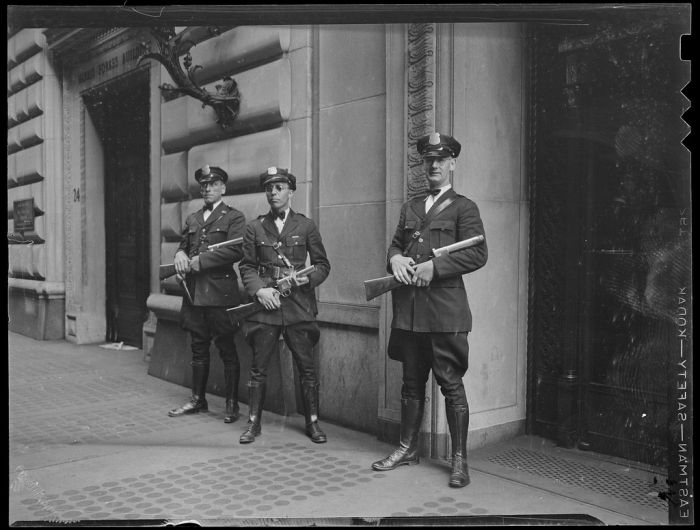History: Boston Police, Behind The Badge, 1930s, Boston, Massachusetts, United States
|
The Embargo Act of 1807, adopted during the Napoleonic Wars, and the War of 1812 significantly curtailed Boston's harbor activity. Although foreign trade returned after these hostilities, Boston's merchants had found alternatives for their capital investments in the interim. Manufacturing became an important component of the city's economy, and by the mid-19th century, the city's industrial manufacturing overtook international trade in economic importance. Until the early 20th century, Boston remained one of the nation's largest manufacturing centers and was notable for its garment production and leather-goods industries. A network of small rivers bordering the city and connecting it to the surrounding region made for easy shipment of goods and led to a proliferation of mills and factories. Later, a dense network of railroads facilitated the region's industry and commerce. From the mid-19th to late 19th century, Boston flourished culturally. It became renowned for its rarefied literary culture and lavish artistic patronage. It also became a center of the abolitionist movement.
The city reacted strongly to the Fugitive Slave Law of 1850, which contributed to President Franklin Pierce's attempt to make an example of Boston after the Burns Fugitive Slave Case.
In 1822, the citizens of Boston voted to change the official name from "the Town of Boston" to "the City of Boston", and on March 4, 1822, the people of Boston accepted the charter incorporating the City. At the time Boston was chartered as a city, the population was about 46,226, while the area of the city was only 4.7 square miles (12 km2). In the 1820s, Boston's population began to swell, and the city's ethnic composition changed dramatically with the first wave of European immigrants. Irish immigrants dominated the first wave of newcomers during this period. By 1850, about 35,000 Irish lived in Boston. In the latter half of the 19th century, the city saw increasing numbers of Irish, Germans, Lebanese, Syrians, French Canadians, and Russian and Polish Jews settle in the city. By the end of the 19th century, Boston's core neighborhoods had become enclaves of ethnically distinct immigrants—Italians inhabited the North End, Irish dominated South Boston and Charlestown, and Russian Jews lived in the West End. Irish and Italian immigrants brought with them Roman Catholicism. Currently, Catholics make up Boston's largest religious community, and since the early 20th century, the Irish have played a major role in Boston politics—prominent figures include the Kennedys, Tip O'Neill, and John F. Fitzgerald.
Between 1631 and 1890, the city tripled its physical size by land reclamation—by filling in marshes, mud flats, and gaps between wharves along the waterfront —a process that Walter Muir Whitehill called "cutting down the hills to fill the coves". The largest reclamation efforts took place during the 19th century. Beginning in 1807, the crown of Beacon Hill was used to fill in a 50-acre (20 ha) mill pond that later became the Haymarket Square area. The present-day State House sits atop this lowered Beacon Hill. Reclamation projects in the middle of the century created significant parts of the South End, the West End, the Financial District, and Chinatown. After The Great Boston Fire of 1872, workers used building rubble as landfill along the downtown waterfront. During the mid-to-late 19th century, workers filled almost 600 acres (2.4 km²) of brackish Charles River marshlands west of Boston Common with gravel brought by rail from the hills of Needham Heights. Also, the city annexed the adjacent towns of South Boston (1804), East Boston (1836), Roxbury (1868), Dorchester (including present day Mattapan and a portion of South Boston) (1870), Brighton (including present day Allston) (1874), West Roxbury (including present day Jamaica Plain and Roslindale) (1874), Charlestown (1874), and Hyde Park (1912). Other proposals, for the annexation of Brookline, Cambridge, and Chelsea, have been unsuccessful.
|
|









